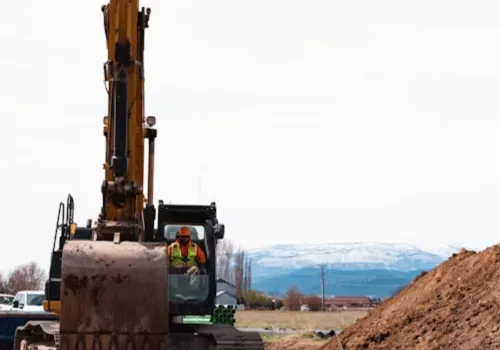
Idaho’s commercial construction landscape is undergoing a major shift as rapid population growth, economic expansion, and evolving industry demands reshape the state’s big box development model.
Over the past two decades, Idaho’s construction industry has expanded by over 60%, fueled by a booming economy and large-scale investments from national retailers and industrial giants. “On our recent projects for Amazon and PepsiCo, we installed miles of conduit under their parking lots,” said Will Goede, vice president of Development for Adler Industrial. These installations support electric vehicle charging, underscoring how dramatically big box development has shifted from the warehouse builds of the past.

Goede and his team at Adler Industrial are witnessing this evolution firsthand. Today’s projects demand infrastructure for sustainability, automation, and adaptability. “The old way is out, and a new way is being ushered in,” he said.
This construction boom has also spurred employment growth. From 2014 to 2023, Idaho added nearly 31,000 construction jobs. In 2023 alone, $6.5 billion was spent on construction — nearly 6% of the state’s GDP, far above the national average.
Retailers such as Walmart are fueling demand with ambitious expansion plans. The company operates 27 stores in Idaho and has launched a five-year strategy to build more than 150 new stores nationally while upgrading existing locations to its “Store of the Future” prototype.
Sustainability is at the heart of this transformation. “Increased environmental regulations on carbon emissions are pushing the national tenants to plan for electric vehicles and equipment,” Goede said. Even if electric trucks and vans aren’t widely used now, developers are future-proofing properties by installing infrastructure for EV charging during initial construction.

The sustainable construction materials market, valued at $301.6 billion in 2024, is projected to reach over $900 billion by 2034. Many projects now adhere to LEED certification standards with features like efficient plumbing, low-irrigation landscaping, and stormwater management systems.
Goede pointed out that national tenants tend to be more rigid in construction specifications compared to regional chains. “National tenants have large spec books with specific requirements to try and maintain a brand standard across the nation,” he said. “Smaller regional tenants are more flexible, making it much easier to put them in existing buildings.”
Material selection also reflects this forward-thinking approach. “Concrete tilt-up construction offers the best long-term durability,” Goede noted. Precast concrete, cork insulation, hempcrete, and bamboo are among the alternatives gaining traction.
Cost-efficiency is also crucial. “It is a tricky balancing act, but ultimately we want our tenants to be successful,” said Goede. “We provide a more expensive HVAC system… programmed to draw cool air into the warehouse early in the morning when the outside temperatures are coolest… much cheaper than installing air conditioning and paying that bill.”
Technology and e-commerce trends are reshaping design. The rise of click-and-collect, expected to exceed $154 billion in 2025, has pushed retailers to incorporate refrigerated staging areas, curbside pickup spaces, and enhanced digital infrastructure.
“We work closely with our electrical engineers to design electrical systems that can be easily upgraded in anticipation of tenants’ power needs continuing to increase,” Goede said. Flexibility is key. Adler buildings are designed for future adaptability — a stark contrast to decades-old rigid commercial layouts.
Idaho’s strategic location continues to attract logistics operations and major investments. Although leasing slowed in 2023, demand rebounded in 2024, especially in Boise, where retail vacancies remain low.
Still, developers face challenges: construction costs range from $300–$500 per square foot, and worker wages have risen 15–25% year-over-year. National construction spending hit $2 trillion in the first half of 2024, but high interest rates are affecting financing options.
Looking ahead, Idaho is projected to lead construction growth in the West. The state expects a 25.6% industry increase between 2022 and 2032, adding more than 16,000 workers.
“The combination of available land, skilled labor and progressive design is why we’re seeing national retailers embrace innovation here,” Goede said. “As they grow, we grow with them.”
Idaho is fast becoming a bellwether for modern construction practices in the Mountain West. Developers, tenants, and municipalities are aligning around smarter, more sustainable building strategies that prioritize energy efficiency, operational flexibility, and technology integration.
With continued investments in infrastructure and workforce development, Idaho is well-positioned to influence not only regional but also national trends in big box retail and industrial construction. From precast concrete to adaptive reuse, from EV-ready infrastructure to flexible HVAC solutions, Idaho’s projects are modeling what the next generation of commercial development will look like.
Originally reported by Heide Brandes in Idaho Business Review.